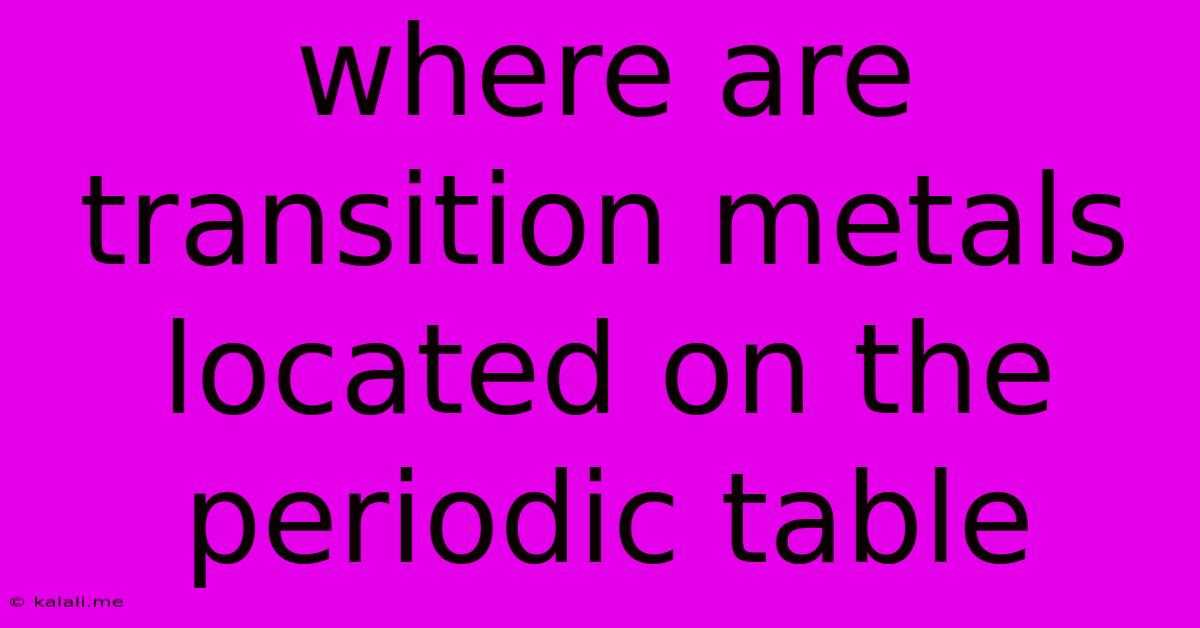Where Are Transition Metals Located On The Periodic Table
Kalali
May 09, 2025 · 3 min read

Table of Contents
Where Are Transition Metals Located on the Periodic Table? A Comprehensive Guide
Transition metals are a fascinating group of elements known for their vibrant colors, catalytic properties, and diverse applications in various industries. But where exactly are these elements located on the periodic table? This article will explore the precise location of transition metals, their defining characteristics, and delve into some of their key properties.
Understanding the Periodic Table's Structure: The periodic table organizes elements based on their atomic number and recurring chemical properties. It's structured in rows (periods) and columns (groups). Elements within the same group share similar chemical behavior due to the same number of valence electrons.
Pinpointing the Transition Metals: Transition metals are found in the d-block of the periodic table. This block sits in the middle of the table, between the s-block (alkali and alkaline earth metals) and the p-block (main group elements). Specifically, they occupy groups 3 to 12.
Defining Characteristics of Transition Metals
Several characteristics distinguish transition metals from other elements:
-
Variable Oxidation States: Unlike many other elements, transition metals can exhibit multiple oxidation states. This means they can lose varying numbers of electrons to form different ions, leading to a wide range of chemical compounds. This property is crucial for their catalytic activity.
-
Formation of Colored Compounds: Many transition metal compounds are brightly colored due to the presence of partially filled d orbitals. The absorption and emission of light by these electrons result in the characteristic colors. This is used extensively in pigments and dyes.
-
Catalytic Activity: Transition metals are frequently used as catalysts because of their ability to readily accept and donate electrons. This facilitates chemical reactions by providing alternative pathways with lower activation energies. Examples include platinum in catalytic converters and iron in the Haber-Bosch process.
-
Formation of Complex Ions: Transition metals readily form complex ions, which are compounds where the metal ion is surrounded by ligands (atoms, ions, or molecules). The formation of these complexes often leads to further unique properties.
-
Metallic Properties: As metals, they generally possess high electrical and thermal conductivity, malleability, and ductility. However, the extent of these properties can vary amongst different transition metals.
Specific Locations Within the d-block
While all transition metals reside in the d-block (groups 3-12), there are some subtle distinctions:
-
Early Transition Metals: These are located in groups 3-6 and tend to have higher melting points and are less readily oxidized compared to their later counterparts.
-
Late Transition Metals: Situated in groups 7-12, they often exhibit greater oxidation state variety and are more easily oxidized.
-
Inner Transition Metals (f-block): Although not strictly part of the transition metals, the lanthanides (rare earth elements) and actinides are sometimes included in broader discussions of transition elements. These are located separately at the bottom of the periodic table.
Practical Applications of Transition Metals
The unique properties of transition metals make them essential in numerous applications, including:
- Catalysis: In chemical industries and automotive catalytic converters.
- Pigments and Dyes: Creating vibrant colors in paints, textiles, and cosmetics.
- Alloys: Strengthening and improving the properties of other metals. (e.g., stainless steel)
- Electronics: In electronic components and circuitry.
- Medicine: In medical imaging and drug delivery systems.
In conclusion, transition metals are strategically positioned in the d-block of the periodic table (groups 3-12), a location that reflects their unique electronic configurations and resulting properties. Their versatile nature makes them invaluable in various technological applications and scientific research. Understanding their location on the periodic table is crucial for comprehending their characteristic behavior and significance in the world around us.
Latest Posts
Latest Posts
-
How Much Is 81 Inches In Feet
May 10, 2025
-
12 8 As A Mixed Number
May 10, 2025
-
What Is The Percentage Of 7 Out Of 10
May 10, 2025
-
How To Find Non Real Zeros
May 10, 2025
-
What Is 300 Degrees In Celsius
May 10, 2025
Related Post
Thank you for visiting our website which covers about Where Are Transition Metals Located On The Periodic Table . We hope the information provided has been useful to you. Feel free to contact us if you have any questions or need further assistance. See you next time and don't miss to bookmark.